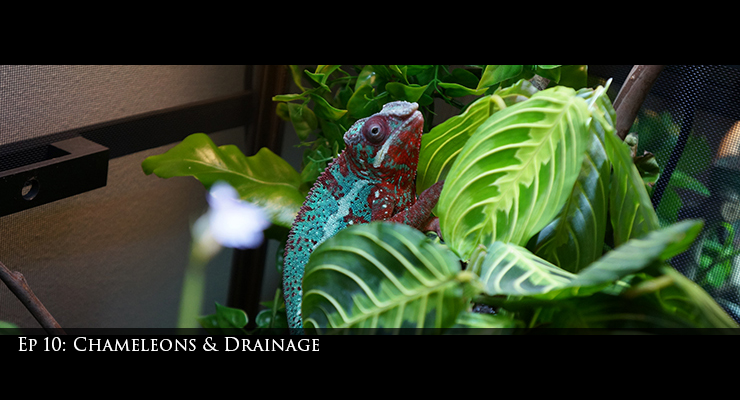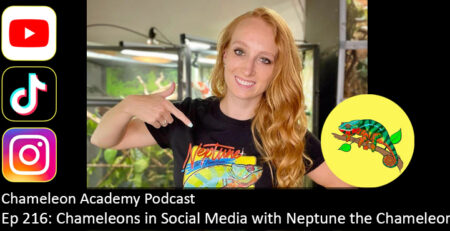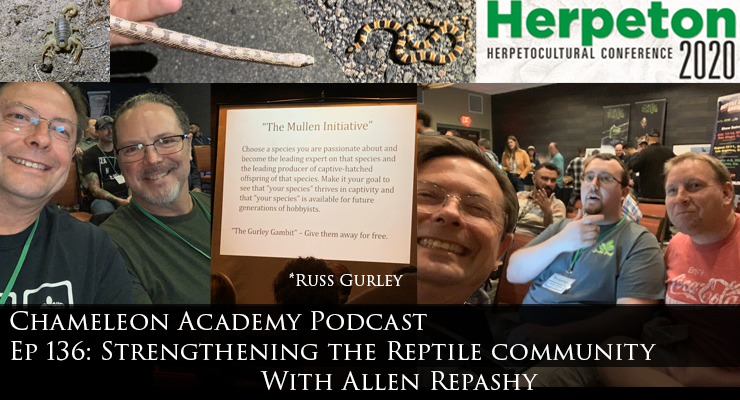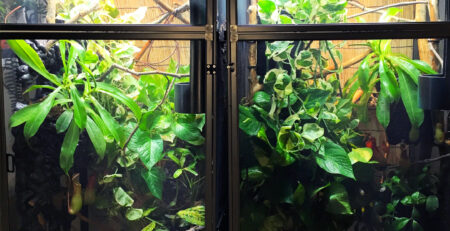Ep 10: Chameleons and Drainage
Summary: Good morning Chameleon Wranglers! Welcome back to part two of our Chameleons and Water segment. In the last episode we talked about the importance of water and how to get it in the chameleon enclosure. This episode is about what to do with the water that goes into your chameleon cage once we are done with it. .
You can listen here:
Show Notes
Good morning Chameleon Wranglers! Welcome back to part two of our Chameleons and Water segment. In the last episode we talked about the importance of water and how to get it in the chameleon enclosure. This episode is about what to do with the water that goes into your chameleon cage once we are done with it. .
.
Links:
Heavy Duty Drainage Trays From Dragon Strand
25″ Heavy Duty Drainage Tray: For 24″ x 24″footprint and below
19″ Heavy Duty Drainage Tray: For 18″ x 18″ footprint and below
Cage Systems with Drainage Trays:
Washing Machine Drain Tray
Gardening Drain Tray
Home Depot Bucket Head Wet/Dry Vac
The Amazon link below makes it easy to purchase this product, but you will be able to find it much cheaper if you drop by a Home Depot in person! You also need a 5 gallon bucket and a crevice tool.
Chameleon Fecals Facebook poop group!
Transcript (more or less)
Transcript (More or Less)
Note: The Chameleon Breeder Podcast changed the name to The Chameleon Academy Podcast in 2020. This ties together the outreach efforts that grew from this original podcast. Although the audio mentions the Chameleon Breeder name, the links here in the show notes have been updated.
Good morning Chameleon Wranglers! Welcome back to part two of our Chameleons and Water segment. In the last episode we talked about the importance of water and how to get it in the chameleon enclosure. This episode is about what to do with the water that goes into your chameleon cage once we are done with it. But first, we have an email question from listener Bridget.
Bill, My name is Bridget and I love listening to this podcast on my way to work. Just wanted to let you know the movie with Pasquel the chameleon was Tangled, not Rapunzel. <yeah, I know…I slipped up on that one!> I would like to know, how do you feel about rescuing chameleons from pet stores that have them in poor conditions. There is a pet store around here that has a veiled chameleon in a cage with a water dish. It looks skinny and I am considering bringing him home, but I don’t want to support this store. How do you feel about this situation?
Thank you Bridget for this question. This is an age old dilemma of us chameleon keepers. We want to save the chameleon, but don’t want to support the people that put this chameleon in this position in the first place. And if we rescue a chameleon from substandard conditions doesn’t that just relegate another to take its place?
The answers to these questions are a whole lot of maybes. This is a much larger question for the community so I’ll expand it to cover this question as a philosophical one and then I’ll close up for specific advice for you.
So first let’s take a look at the pet stores themselves. You have anything from small one location pet store, sometimes termed “mom and pop” stores all the way up to large chains such as petco and petsmart. There are some independents of various sizes inbetween those. The problem with all of these is the same, though. Chameleons are specialty animals and if you are not able to spend time and effort on them specifically things go astray. Chameleons just can’t be kept like other reptiles. Some stores can pull it off, and some cannot. Even reptile specialty stores have had questionable chameleon set-ups. One thing I do want to add here is that there are some cases where the pet store will put a water dish in with a chameleon only to avoid charges that they are abusing their animals by withholding water. It is easier to put in a water dish in every cage than it is to explain that different animals need different conditions. Check the top of the cage to see if there is a dripper as well or talk to the caretaker to see if they have a spraying schedule. It is best to get the full picture before getting too upset.
And, just a note here. Pet stores are often run by animal lovers. Reducing them down to purely dollars and cents is not fair. Yes, they are running a business, and things are tight for pet store operators, but do not dehumanize them just because they are running a business. Talk to them first. Then you can dehumanize them – just kidding. Be good people, okay?
Also, if you do talk to them, realize that they have no idea who you are. You are coming in with all this crazy talk about how chameleons should be taken care of. You may not be the first to bring this up. The last person that came in spouted off a different list of do and do nots. What is the poor guy to do except smile and hope you go away? You may know your husbandry is solid, but how would someone who is not part of the community know if what you are saying is true?
A large pet product corporation makes red night lights for chameleons and another on makes waterfalls that go inside the cage. You can tell they are for chameleons because they have chameleons on the box! And no-name you crawls out of the woodwork and blasts them for having a nightlight? Who are you? And, oh yeah, they got blasted by some other chameleon lover last week for having plastic plants in the chameleon cage. But then someone else said plastic plants are fine. There is no shortage of experts of all levels of experience. Just a shortage of consistency in what those experts say. This doesn’t mean you shouldn’t be out there trying to make the world a better place for chameleons, just go into it understanding why it is difficult for other people to know if you really know what you are talking about. Establishing a relationship with this pet store so they know who you are and have a trust built up will go a long ways.
But anyway, let’s talk about rewarding the store giving the chameleon substandard care. This is always a mixed bag because you feel like a hero by freeing a living being from a cycle of misery while at the same time you are slime by being part of making sure that cycle continues.
Consider whether you are economically important. If your corner pet store is trying out a chameleon to see if they will sell and that chameleon dies then that one chameleon dying will ensure none others take its place. If that same pet store was given a clutch of veiled chameleons on consignment then it doesn’t matter to the owner how many die and how many are sold. You buying or not buying is irrelevant. So, theoretically, buying a sick or abused chameleon does, in a way, reward offering an animal in that condition, but the actual damage or lack thereof maybe negligible.
In a large name pet supply such as Petco or Petsmart you have about 1000 store locations each. Decisions are made regarding the economic viability of an animal regarding not only how many they sell across all stores minus how many die, but also what products the store carries that attached to that animal. And if a chameleon dies do you think Petco takes that loss or passes it on to the breeder? I bring this up only to make you realize that, although a handful of people can definitely make a difference in how things run, the decision to rescue a chameleon from Petco is not going to tip the scales in either direction. There would have to be a much larger, coordinated effort to make an economic dent in chameleon sales. If you started a group of rescuers that made it a point to rescue 100 chameleons a month from one of these store brands then, yes, you are now economically important. When your rescue organization starts getting corporate Christmas cards from Petco and Petsmart then, yes, your rescue activity may be driving a decision somewhere.
We most often see this battle raging when someone sees a chameleon that needs rescuing, their heart beaks for this poor creature and they create a fund raiser to free the poor guy and send him to a better home. My opinion on this is that we should concentrate what effect this action and our reactions has on the chameleon community. Because, until this activity becomes economically relevant to a 1000 store chain, this really just affects the chameleon community. Where are most of the first time big chain store chameleon customers? I would venture that they are not in the chameleon community. We get a lot of them after they make their purchase, but not before. So our arguing and debating within the chameleon community and deciding to n ever buy from them is economically irrelevant to the bog box stores. We can do things such as education and work with management to make the situation better, but blasting some good intentioned soul that wants to raise $200 to buy a chameleon is counter productive. Your message is going to a group of people that is no longer a meaningful part of the chameleon based economic environment at the big pet chains. So, I say, let them rescue that chameleon. It is more valuable to our community to have people that care so much than it is for everyone to toe the party line of big pet store = evil. I am not going to encourage this kind of behavior as rescuing a chameleon suggests that adding this chameleon to your household was not planned and the word “rescue” can be used to justify a decision being made prematurely. But a couple of rescue efforts a year is not going to result in a flood of new chameleons being stuffed into a pet store cage. If the rescue effort has a good home at the other end for the chameleon then I suggest we focus on the good it does that one life. But there is also the good it did our community for a small part of it to come together and do something positive. If there was no real harm done (an theoretical harm doesn’t count) it doesn’t have to be supported, but there is no reason to introduce grumbling against the couple of people doing the best they can to do something positive. Believe me, there is plenty of time for them to get jaded by the system and discouraged by their fellow human beings. Make sure you have a very good reason before you squash idealism. Yes, often idealism needs redirection, but seriously reconsider any words of discouragement. We humans tend to default to discouragement. This is not a good thing. Discouragement is easy. If you must speak out, take the challenge of providing positive redirection. If that is not possible, silence should be broken only if there is damage to be avoided.
Now Bridget, my opinion in your case is to make sure you purchase a chameleon in the best heath possible. This is to ensure your experience is as positive as can be. You are looking at around 5 to 7 years of life with a healthy chameleon. That said, there are a special handful of people who look for the down and out. They want special needs chameleons and have the time and money necessary to give a good life to chameleons that are not in prime condition. Do not take on a sick or weak chameleon unless you have the means to provide vet visits. But that is the logical side talking. If you have fallen in love with this chameleon, are buying it with eyes wide open as to the health condition, and have a space in your life where it will fit then go ahead. I find sleeping on a decision for a night does wonders. And, of course, take a couple pictures of the chameleon and ask trusted chameleon people what they think of the health so you have some idea if there is any rehabilitation necessary.
Alright, now let’s get to the meat of this episode and discuss drainage. We already discuss getting water into the cage and what form it will take. Eventually, though, all of that mist and drip will end up at the bottom of the cage. Unfortunately, that is also where poop and escaped feeders end up so we are going to have to deal with this one way or another! So let’s break down your bottom-of-the-cage elements.
1) Standard PVC Floor. The most common floor you’ll run into is a flat sheet of PVC. This is the industry standard as it is simple and effective. Most often it takes the form of a plain white sheet of PVC plastic resting on the bottom frame. In most cage designs, but not all, it can be removed for cleaning. Usually it is white, but sometimes you will find green or black. One company, Canvas Chameleons, offers decals so your cage floor looks like a forest floor. When water falls on the floor it puddles until there is enough water that it flows towards the sides and then it will trickle down off the floor panel and out the cage. It is advisable that there be something to collect that water. If you keep potted plants on the cage floor then this is the floor option of choice as it will provide the support necessary. Whether you have potted plants or a bare floor, I suggest drilling small holes all around the floor to allow water to pass more freely out of the cage. Specifically pay attention to any area around plants or anything else placed on the floor as objects will create an indentation and water will gather there. And here is your Cham Tip of the day: If you get stains on your white PVC floor from water, dirt, and various unnamed things hitting the floor you may notice that it is difficult to get those stains out. Go to any grocery store or home improvement store and look for “Mr. Clean’s Magic Eraser”. It is a cleaning pad made of some mysterious white spongey material and when you use one of these cleaning pads the stains just disappear. And I know you are saying, “Bill, I have tried to get these stains off before and it is impossible! How can this simple white pad perform this miracle?” And the answer is, “I have no idea. It uses magic just like it says it does.”
“But,. Bill, there has got to be an answer!”
“No. There doesn’t. There are some things that mortal man was not meant to know. Perhaps if Eve snagged another apple off that tree we’d have an answer to this one, but we don’t so we will just have to be content extracting the mysterious of galactic expansion and acknowledge that the truth behind the magic eraser is beyond our comprehension. Just make your floors white and go about your day.”
2) Screen Floor. The idea of replacing the white PVC floor panel with a screen panel was introduced to the market by Ed Kammer of Kammerflage Kreations as the Drip Easy system. It was designed as a way to avoid pooling and have the excess water go directly through the floor into the drainage tray. The Dragon Strand caging company now offers the “Drip Easy” system for select cages under a special agreement with Ed Kammer. Although it accomplishes the original goal of avoiding pooling water beautifully, it has gone on to provide another feature – to make the floor disappear. With a black drainage tray and a screen floor, the floor of the cage visually disappears. This is the direct opposite of a blatant white floor! This goes along with Dragon Strand’s vision for caging. With the Dragon Ledges, chameleon keepers have been able to create floating gardens, if you will, independent of the floor. Having a screen floor makes the floor visually disappear and creates a much more naturalistic arboreal appearance.
3) Substrate Trays. A substrate tray is a plastic or PVC tray that fits on the floor inside the cage. This is used to hold soil, coco fiber, sphagnum moss or any other substrate combination. Substrate trays have restricted uses with chameleons because, well, chameleons are arboreal, which means they live in trees. So, unless you are keeping pygmy chameleons or a gravid female of an egg laying species, you probably do not want to bother with a substrate. Substrates take a lot of work and if you don’t need it, don’t put one in. There are reasons for substrates and there are ways of doing it correctly. There are aesthetics and humidity strategies that incorporate substrates, but if you do not have a master plan that just cannot be accomplished without substrate then don’t bring that complication into your husbandry.
One thing you do not want to do is use a substrate tray as a water catch. Remember, substrate trays are inside your cage. Your goal is to get the water out of the cage. Any water left inside the cage will pool, mix with feces, and provide an unhygienic and possibly parasite laden poop soup for escaped feeders to crawl through and, thus, provide a quick shot of bio-poison to your animal when he eats that feeder.
We do have a problem in our industry where substrate trays are cheaper to make than drainage trays that go under the cage. Thus the cage manufacturers that target the low cost market and entry level customers have been able to get away with offering only substrate trays. Whether this is because of ignorance – maybe these companies do not keep chameleons themselves or business greed – once the customer figures it out the money has been long spent, this is one of the truly irresponsible product strategies that afflict new chameleon keepers. What you need is a drainage tray.
4) Drainage Trays are trays that fit under the cage. They provide a collection point for excess water outside the chameleon’s living space. These are a bit more involved than substrate trays because they must provide support for the cage which sits on top of them. Currently, the only cages on the market that have drainage trays specifically designed for them are all Dragon Strand cages – I keep chameleons so a drainage solution is a non-negotiable feature – and the #1 though #5 screen cages sold through the online supplier LLL Reptile. At the time of this podcast episode (which is early 2016) no other major commercial caging manufacturer offers drainage trays for their products. Because of slight dimensional differences, the standard Dragon Strand and LLL drainage trays will not fit the Chinese import cages. These include Reptibreeze, Exoterra, and DIY. I do have a Heavy Duty line of drainage trays offered through Dragon Strand that will fit those cages so there is a professional solution available for any of the square footprint cages offered.
I really wasn’t designing it for my competitors, but as a tool for people who would like to put potted plants on the floor of their Dragon Strand cage. It has thick reinforcement to hold the weight of potted plants on the floor of the cage so there is an extra cost associated with that. If the heavy duty tray is more than you need then you can check your local home improvement center for washing machine drainage trays. They aren’t as aesthetic as the drainage tray made specifically for this purpose, but it will do the job. If you go in the washing machine tray direction then just be sure to raise the cage up above the water level using blocks of wood or something else to keep the water level below the cage floor.
Alternatively, there are non-draining trays produced for the gardening industry, but they aren’t much cheaper than the Dragon Strand trays so the need to add spacers and the resulting nonprofessional look may negate any savings. Though perhaps the savings in shipping from a large corporation instead of a small caging company may make it worth it to do a self-build. If you go the Dragon Strand route then just put the cage on top and you are done with a clean looking solution! It is up to you to balance out your personal preference of money savings versus the time and aesthetic compromise. Whatever drainage solution you choose, make sure it collects water outside the cage and out of reach of the feeder insects and the chameleon itself.
The rectangular footprint cages offered by Zilla or Exo-Terra are problems that you’ll just have to get creative with. Dragon Strand does have rectangular footprint cages that you may check to see if the dimensions match.
If you are constructing your own drainage tray or purchasing a washing machine pan or gardening tray then just make sure you have figured out how you will empty the tray of water. The Dragon Strand drainage tray options have a space in front of the cage which allows a turkey baster or wet vac crevice tool to fit in and suck up the water. Don’t think you will be lifting the cage off each time and taking the drainage tray out to the sink to dump it. You will be sloshing water all over on your way to the sink. Leave the cage on the drainage tray and use one of the water extraction methods that we will go into very soon.
5) Other Drainage Solution. Drainage trays are the drainage solution of choice for a small number of cages or cages in your living room or bedroom. If you have a reptile room or a large number of cages then it may be worth it to create a drainage table which collects the water and brings it all to a collection bucket or even a self-priming pump. For one reptile room I used rain gutters to run under the racks of cages and these gutters emptied into a Drain-a-saur self-priming pump which would pump the water into the utility sink drain when it reached a certain level. This automation made the water cycle simple. That is until it had an issue and flooded the area. Just remember folks, automation cuts down on the amount of time you have to spend on doing something, but it takes it own time to maintain as issues always seem to crop up. Don’t get complacent or else your lesson to be learned is right around the corner!
Did all of this just boggle your mind? The show notes for this episode will contain all these options with pros and cons and links to more information. Go there and it will be all laid out for options that are the cheapest to the easiest, but everything I lay out will be effective and hygienic.
Once you have a water collection strategy you’ll need to have a method for removing the water from the tray.
The first is basic evaporation. Especially if you live in dry environments, evaporation may get rid of most if not all the water from your drainage tray. This, of course, depends on the ambient humidity and how much you water.
2) Turkey baster. The most low tech and cheapest water removal tool is a turkey baster. If you only have one chameleon you can get away with a turkey baster dedicated to this purpose. They range from $.99 to $10 so go ahead and splurge.
3) Wet vac. My favorite water removal method is a wet vacuum. As I mentioned, the Dragon Strand drainage tray options have a space in front of the cage which allows a crevice tool to fit in and suck up the water. For about $30 you can get a bucket head system from Home Depot which is a wet/dry vac head, a 5 gallon bucket, and a crevice tool. If you have more than a cage or two then consider the convenience offered by a wet/dry vac. I like the bucket head concept because it is an inexpensive way to have a 5 gallon water collection. There are self-contained wet vacs which are well made and work, but their water capacity is not as high. If you just have a couple cages it is fine. But if you have a reptile room then water collection capacity is a serious consideration!
4) Bulkhead and gravity drain
There is a middle ground between having a bunch of cages on drainage trays and having a customer drainage system constructed in your room. Some keepers have taken drainage trays and have installed bulkheads on the back which allow water to drain out of the tray through ¼” tubing into a bucket. This takes a little familiarity with tools, but can be applied to cages in a reptile room or a cage sitting in the living room on top of a small cabinet which hides the misting system and the drainage bucket.
Now let’s talk about the great chameleon and husbandry system health monitoring that floors and drainage trays offer the keeper.
A major part of ensuring that your husbandry is sufficient is checking the floor of your cage on a daily basis. The poop you find is an indicator of the health of your chameleon. A healthy poop will be moist and tightly packed. You will get a feel for the standard size and frequency as well. Any deviation from the norm is a clue to something going on. Poop is great because it is an early warning system.
Is the poop dry? That is a sign to check your misting system or drip system. Running out of water? No longer pointing at a leaf? Plants grow and leaves die. If the perfect drinking leaf is no longer where it is suppose to be you need to change your misting or dripping location. Remember automation breeding complacency? Yeah, not only do you need to make sure water is still getting into the cage you have to make sure the drinking surface remains! Is the misting nozzle clogged with mineral deposits? The leaf which was perfect for the mist may be useless if what is coming out of your mist nozzle is just a dribble dropping uselessly to the floor. Does the misting system need to be “burped”? I went over this last episode. But as a review, the diaphragm pumps can have problems if they have been run dry. Although they won’t be damaged, they need to be “reset” to provide the proper pressure. This means disconnecting the nozzle system at the pump, allowing the pump to run until a stream of water comes out, and then reconnecting the output tubing.
Is the poop small? The obvious first conclusion is that the chameleon is not eating as much food. There could be other things going on, but the important thing is that you are vigilant and know that something is up and are looking for other clues. Not every deviation from your baseline poop sample is cause for alarm, but it does put you on alert. This is what we are looking for. This is the way to nip things in the bud before they become major issues.
Is the poop too wet, smelly, or ?? You could be looking at sickness or parasite activity with various differences in the poop. You may not know what something different means, but the fact that you know something is up is important. If you start seeing something different then you can start researching the chameleon forums or you favorite Facebook group for people who have seen this before. There is actually a poop group on Facebook which I will link to in the notes. But this change will be important information for your vet if it progresses. The important thing is that you are on alert and are looking for any other small sign of trouble that suggests that this change in consistency is more than just a funky digested hornworm. Oh yeah, changing diet may result in different looking poop. Take all these things into consideration when you are doing your analysis!
Has your chameleon not pooped in a couple days? Expect a poop every day or two. If you go longer than that then either your chameleon is not getting enough food or else is constipated. Check your food dish. Are feeders getting away before they are eaten? Hopping out? Climbing the sides? Are you putting in feeders that are too big or too small or just not what interests your chameleon?
You can do these poop based health checks whether your have solid PVC floors or the screen floor.
The drainage tray is actually a better misting system check than poop because it is a daily check item. If you are not seeing the right level of excess water in the drainage tray it is a red flag. Is your mister out of water? Unplugged? Has the seconds timer been set to “off” instead of “auto”. Is the misting nozzle clogged? Does it need to be burped? Same things as above. Your drainage tray is a window into the health of your misting system. If your misting system is working properly you will have water to remove from the drainage tray. This misting system health double check is one downside to automating your drainage. You then lose this monitor to the misting system. If you automate anything you must have an independent method of ensuring all is working. In the example of a misting system you have your checklists to make sure everything is in order: water basin filled? Mister set to” auto run”?, etc…but the check is not complete until you deal with the output which is, in this case excess water.
Drainage may be a simple concept, but not taking it seriously can, indirectly, have effects on your chameleon’s health. Some keepers decide not to have a drainage solution, or, more commonly, they were not sent home with one because the store didn’t have a drainage tray to sell. This can have negative effects on your chameleon because then you are constructing your watering strategies and cycles around not damaging the tables or wall or furniture around the chameleon cage. Those strategies need to be focused on properly hydrating your chameleon.
Some people place a towel under the cage to catch what little bit of spraying seeps through the cage floor. If this technique is working for you then I would be concerned that you are not giving your chameleon enough water. Obviously, I am not there so you will have to be educated and responsible enough to make this judgment yourself. Advanced keepers who master the control of their vivarium’s humidity and other parameters can mist just enough to coat the surfaces and have little excess water. This is a high level skill and the person doing this will be monitoring their chameleon’s health daily to ensure hydration.
So, here’s our summary for drainage:
1) Collect water outside the cage. Do not use a substrate tray inside the cage to collect water.
2) Drainage trays for chameleon cages can be found through Dragon Strand for any of their cages or LLL Reptile for their #1 through #5 cages.
3) The only commercially made Drainage Trays that fit Zoo-med reptibreeze or other manufacturers is the Heavy Duty trays by Dragon Strand
4) Although not as aesthetically pleasing, washing machine drain trays and non-drainage gardening trays are economical and functional ways of collecting excess water under a cage Just remember to plan for cage supports in these trays so the cage bottom is not under the water line.
5) The floor of your cage is a great way to monitor your chameleon’s health through their poop.
6) Your drainage tray is a great way of verifying your mister’s performance.
Thank you for joining me here today. I am always interested in novel, simple, clever, and effective solutions. If you have a method to handle drainage that I have not listed here then send it to me at bill@chameleonbreeder.com or on our Facebook page linked to in the show notes. Our account on Instagram is quite active and you are welcome to join us there! I post things that have to do with this podcast and in between that, I just sprinkle chameleon pictures and videos randomly through the day. I’d love to have you join us there. Well, the time is nigh and so that, is a wrap!













